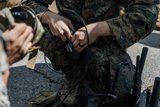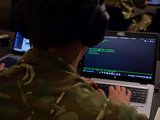Raytheon's Total Ship Computing Environment passes critical review
Raytheon Company's open architecture Total Ship Computing Environment (TSCE), the integrated mission system for the DDG 1000 Zumwalt-class destroyer, recently passed a key Technology Readiness Assessment.
The TRA, conducted by the US Navy, confirmed that TSCE is now at Technology Readiness Level 6 as a result of the system's ability to operate in a relevant end-to-end environment. The review revealed a high pass rate for system requirements as well as low software defect counts.
"In developing more than six million lines of code, TSCE is one of the most complex software projects ever undertaken," said Raytheon Integrated Defense Systems' (IDS) Bill Marcley, vice president of Total Ship Mission Systems. "With each successful software milestone, we are mitigating risk and enhancing the reliability of this highly capable open architecture system."
Members of the Navy's TRA panel commended the robustness of Raytheon's simulation environment and the company's thorough approach to integration and testing. From design to production, Raytheon has partnered with the Navy to develop a thorough testing process to mitigate any potential risks involved with integrating the mission system software with the ship's hardware.
Raytheon's TSCE encompasses all shipboard computing applications, including the combat management system; command, control, communications, computers, and intelligence elements; ship machinery control systems; damage control; embedded training; and support systems. The system leverages a modern open system architecture that provides a scalable platform for cost-efficient delivery of new mission capability.
TSCE delivers an unprecedented level of modularity and automation, helping to advance the Navy's open architecture goals. The sailor-centric, human-computer interface, combined with the high level of automation achieved with TSCE, is a primary driver for the significant reduction in manning for the DDG 1000 Zumwalt-class destroyer when compared with today's Arleigh Burke-class destroyers.
Raytheon performs software work for the DDG 1000 program at IDS Headquarters, Tewksbury, Mass.; at the Seapower Capability Center, Portsmouth, R.I.; at the Surveillance and Sensors Center, Sudbury, Mass.; at the Expeditionary Warfare Center, San Diego, Calif.; and at several other Raytheon facilities.
Source: Raytheon
More from Digital Battlespace
-
![EID to unveil new vehicle communication system at DSEI]()
EID to unveil new vehicle communication system at DSEI
The Portuguese company’s naval communications system is in service across more than a dozen countries. It has turned to its home nation for support in developing a new vehicle based C2 system.
-
![Chess Dynamics successfully demonstrates Vision4ce AI-driven tracker]()
Chess Dynamics successfully demonstrates Vision4ce AI-driven tracker
The Vision4ce Deep Embedded Feature Tracking (DEFT) technology software is designed to process video and images by blending traditional computer vision with artificial intelligence (AI) algorithms to present actionable information from complex environments.
-
![Wave Relay devices cleared for security use on commercial systems in industry trend]()
Wave Relay devices cleared for security use on commercial systems in industry trend
Persistent Systems has been cleared by National Security Agency (NSA) to transmit sensitive data on commercial networks. The devices are added to the NSA’s Commercial Solutions for Classified (CSfC) component list which also includes other companies’ products providing the same security.
-
![UK teases cyber spending boost in Strategic Defence Review ahead of “imminent” release]()
UK teases cyber spending boost in Strategic Defence Review ahead of “imminent” release
The release of the UK’s Strategic Defence Review (SDR) has been long promised as mid-year. It is possible it could be as early as 2 June although the UK Ministry of Defence (MoD) continues to play its cards close to its chest.
-
![Intelsat emphasises SATCOM resilience for SOF in contested domains (video)]()
Intelsat emphasises SATCOM resilience for SOF in contested domains (video)
Intelsat outlines how its multi-orbit SATCOM architecture is enhancing connectivity and resilience for special operations forces operating in degraded and contested environments.
-
![US Space Force’s next-generation missile warning system moves forward with $500 million in new contracts]()
US Space Force’s next-generation missile warning system moves forward with $500 million in new contracts
Next-Generation Overhead Persistent Infrared (Next-Gen OPIR) satellites are intended to provide early warning of missile launches from any location worldwide and new ground stations will result in expanded coverage of critical missile warning.























